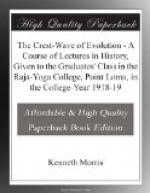With him in the same decade came most of the luminaries that made his age splendid: Virgil in 70; Horace in 65; Vipsanius Agrippa in 63; Cilnius Maecenas in what precise year we do not know. The fact is that the influx of vigorous light-bearing egos, as it decreased in China, went augmenting in Italy: which no doubt, if we could trace it, we should find to be the kind of thing that happens always. For about four generations the foremost souls due to incarnate crowd into one race or quarter of the globe; then, having exhausted the workable heredity to be found there,—used up that racial stream,—they must go elsewhere. There you have the raison d’etre, probably, of the thirteen-decade period. It takes as a rule about four generations of such high life to deplete the racial heredity for the time being,—which must then be left to lie fallow. So now, America not being discovered, and there being no further eastward to go, we must jump westward the width of two continents (nearly), and (that last lecture being parenthetical as it were) come from Han Chaoti’s death to Augustus’ birth, from China to Rome.
But before dealing with Augustus and the Roman prime, we must get some general picture of the background out of which he and it emerged: this week and next we must give to early and to Republican Rome. And here let me say that these two lectures will be, for the most part, a very bare-faced plagiarism; summarizing facts and conclusions taken from a book called The Grandeur that was Rome, by Mr. J. C. Stobart, of the English Cambridge. One greatest trouble about historical study is, that it allows you to see no great trends, but hides under the record of innumerable fidgety details the real meanings of things. Mr. Stobart, with a gift of his own for taking large views, sees this clearly, and goes about to remedy it; he does not wander with you through the dark of the undergrowth, labeling bush after bush; but leads you from eminence to eminence, generalizing, and giving you to understand the broad lie of the land: he makes you see the forest in spite of the trees. As this is our purpose, too, we shall beg leave to go with him; only adding now and again such new light as Theosophical ideas throw on it;—and for the most part, to avoid a tautology of acknowledgments, or a plethora of footnotes in the PATH presently, letting this one confession of debt serve. The learning, the pictures, the marshaling of facts, are all Mr. Stobart’s.




